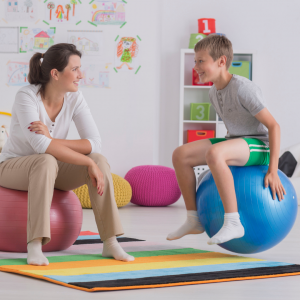Have you heard before that ADHD students need to move to learn best? Various studies support that idea. Unfortunately, most of those studies then list classroom-acceptable ways to move, instead of rethinking how we teach our ADHD kids.
Homeschoolers need to think differently
 What do I mean by “classroom acceptable ways to move?” I mean things that teachers with 25 students can rationalize and try to ignore. Wiggly seat cushions, fidget toys that don’t move too much, and even theraband on chair legs that kids can push on are seen as acceptable in classrooms. And if those work in your homeschool, that’s great.
What do I mean by “classroom acceptable ways to move?” I mean things that teachers with 25 students can rationalize and try to ignore. Wiggly seat cushions, fidget toys that don’t move too much, and even theraband on chair legs that kids can push on are seen as acceptable in classrooms. And if those work in your homeschool, that’s great.
However, I believe that kids with ADHD learn best when movement is actually part of the lesson. For example, you can teach geography by working puzzles, or throwing bean bags at a wall map and trying to hit the right country. Learning about a country can mean your child is preparing foods from that place while discussing the country and the significance of the foods you are making. Cooking corn tortillas while learning about the Aztecs, for example, blends movement with history. The Aztecs were so successful because the carbohydrates in corn gave them the energy to build an empire.
Movement Enhancing the Learning
 If you are educating an ADHD child, look for ways to add movement to your lessons. Can your child do a craft that goes with the story while you read aloud? Coloring is a great choice, but sewing, weaving, or working with clay are even better for many kids. While fidget toys are fine, making a connection with the story is even better. This is why I like crafts in homeschooling better than just giving a child a way to move that isn’t related to the lesson. Deeper learning happens when your lesson and their movement combine.
If you are educating an ADHD child, look for ways to add movement to your lessons. Can your child do a craft that goes with the story while you read aloud? Coloring is a great choice, but sewing, weaving, or working with clay are even better for many kids. While fidget toys are fine, making a connection with the story is even better. This is why I like crafts in homeschooling better than just giving a child a way to move that isn’t related to the lesson. Deeper learning happens when your lesson and their movement combine.
For younger kids, there are many ways to add toys and play to a lesson. Sensory bins can be created with any theme and used while you read aloud. Toy soldiers can wage wars across the carpet as you teach. Creating a train track can bring alive a lesson on Westward Expansion. There is no age limit on when your child should stop playing with toys, so don’t assume that these ideas won’t work for your child until you try them out.
Movement for all Ages
For older students, finding science projects, puzzles, and hands-on projects is going to create better learning than any paper they can sit still and write.
 I recommend saving the yoga balls and fidget toys for older kids. Even adults can benefit from using them. Older students who need to write papers or work longer at a desk can use a yoga ball as a chair while they work. It activates their core and helps with staying alert and focused. It just isn’t going to activate the whole brain the way project-based learning will.
I recommend saving the yoga balls and fidget toys for older kids. Even adults can benefit from using them. Older students who need to write papers or work longer at a desk can use a yoga ball as a chair while they work. It activates their core and helps with staying alert and focused. It just isn’t going to activate the whole brain the way project-based learning will.
As a homeschooler, I hope you will try some of these ways to get your ADHD kid moving and learning.
Many ideas to help kids move while they learn are included in our Five Senses Literature Lessons programs. Visit our store to see if any of them are right for your child.





I completely agree with all of these ideas. Having ADHD [medication isn’t an option for me] makes it very hard to sit still. The yoga ball is my desk chair at work. I’m always having to play with a ribbon– regardless of whether I’m sitting , writing , reading , whatever. My hand must be occupied. It honestly took me until this year to figure out my ‘weird ribbon thing’ was the result of the ADHD I’ve had since childhood.
It took a long time for the ADHD diagnosis to come up because I was very well-behaved and decidedly not hyper. Mind you , I’m 36 , so things have come a long way since the time I was a child. I made A’s and B’s and could become hyperfocused if I was interested in something. While I always shook my leg under my desk , I wasn’t outwardly fidgeting or ‘zoning out.’
I truly believe my diagnosis of bipolar disorder was incorrect because doctors were interpreting ADHD behaviors for mild manic symptoms.